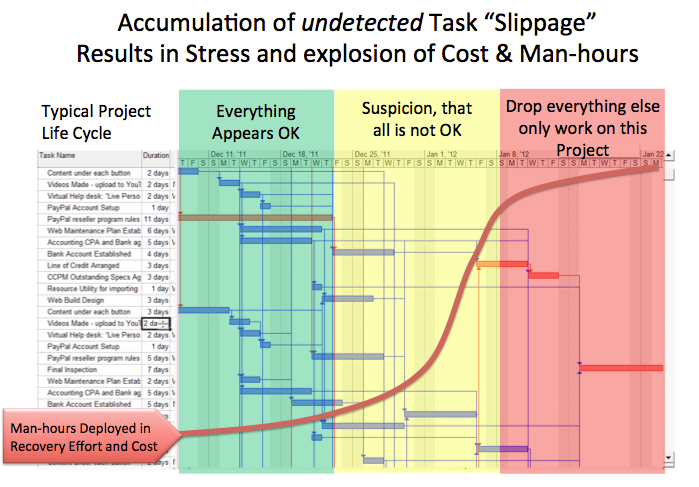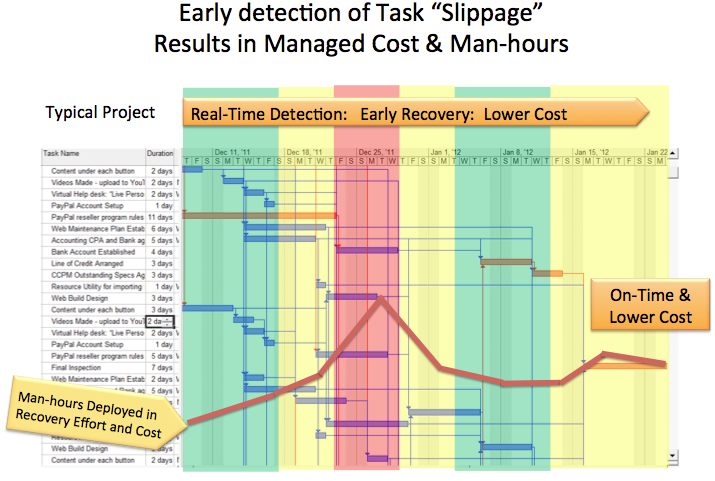Why are Projects Late? An introduction to Critical Chain!

Project Teams are expected to complete Projects before or on the committed due date, within budget and without compromise to the original specification. History shows a pattern of project underperformance, with most projects not meeting one or more of these expectations. Many external factors are blamed for this under performance; however the PM method is not questioned.
The frequent switching of the Critical Path (CP) when Tasks are updated is not questioned. This CP switching certainly increases Multi-Tasking in-turn causing excessive set-up, set-down and re-set-up, draining the available Resource capacity. This white paper builds on the foundational work laid by Critical Path and suggests that using well established Process Control Methods, tactically located “Shock Absorbing’ buffers can be inserted into the project network effectively stabilizing the Critical Path, which reduces the wasted energy chasing fluctuating priorities. In addition, these Buffers provide sufficient Early Warning and identify exactly where and when intervention is required to keep the project inside a budget, within due date and to specification.
Critical Path
Critical Path has been the generally accepted method of managing projects since the cold war. Building on this foundational work and introducing the generally accepted method of Process Control, the Critical Path can become a Stable Datum Plane, enhancing predictability while reducing wasted resource capacity. Effective Control Buffers serve two purposes: absorbing ‘Common Causes’ variation while providing timely warning of ‘Special Causes variation. Containing variation increases the overall probability of Project Management meeting the project success criteria.
Purpose
This paper points out the origin of the frequent priority changes that lead to ineffective and costly multi-tasking, which results in wasted resource capacity and increased costs. It demonstrates how to effectively use an accepted Process Control technique to stabilize the Critical Path (CP).
Background
A frequently changing Critical Path adds to project instability, especially towards the end of the project life cycle when many tasks appear as incomplete and urgent. This last third of a project is a chaotic environment, significantly increasing the man-hour cost and drains resources away from other projects to keep an imminent project on track. This cycle repeats itself from one project to the next.
By tactically locating Buffers within the project network, these buffers protect against uncertainty and are effective ‘radar’ screens. Project Management Officer (PMO) will know exactly when not to intervene, also when and where to intervene with corrective action. The Buffers also provide the added benefit of stabilizing the Critical Path or longest chain of dependency – by including the Project Buffer as part of the Critical Path; this effectively creates a ‘fixed datum plane’ or stable spine within the project network and provides stability during execution.
Topic 1: Early identification of Task Slippage
The recognition of Task ‘slippage’ and Task duration overruns is not easily detected in the early stages of the Project Life Cycle. This undetected Task ‘slippage’ accumulates through the first third of the project and is undetected until the second third of the Project Life Cycle, when suspicions are aroused that the project is falling behind and the Due Date is in jeopardy. PMO’s response is to redouble efforts, add resources and even re-plan the project. Fig 1.
A Project with an effective ‘Early Warning’ system will keep the project within manageable control limits effectively containing the cost of recovery. Cost overruns and commandeering resources from other projects is avoided. Fig: 2.
Early visibility of when and where management intervention is required in the life cycle of a project effectively reduces the amplification of costs observed in the final third of the project.


Topic 2: A Critical Path Task has a higher priority than a non-Critical Path Task
This is true during planning. However, the Critical Path method without buffering, the moment execution starts the planned schedule rapidly changes. Mostly due to the assumption that the planned Resources will be available when scheduled, however on-time availability of Resources is rare in a complex project environment having a shared Resource pool. Contention between Resources often creates significant schedule changes and the Critical Path begins an induced ‘random’ vacillation or frequent changes. The PMO is then left with no guidance on which of the changing priorities is the most important. Task priorities change and the Resources frequently ‘jump’ from one unfinished Task priority to another. This begins a cycle of capacity wasting ‘Multi-Tasking’. This is most observable in the costly expedited efforts during the last third of the Project Life Cycle. Fig1.
Topic 3: Adding Buffers must not extend the total duration of a Project
In order to remain commercially competitive, the total duration of a Project must be reduced – this means limiting embedded Task ‘safety’ time and allocating only the “touch time” per Task.
However, remaining commercially competitive and maintaining a reputation of being a reliable Supplier, means adding safety time and padding Task durations. Adding time in planning may extend the Total duration of the Project beyond a competitive due date.
The direction of the Solution:
Remove the safety-time from each Task duration, then tactically reinsert the removed safety-time as aggregated time Buffers within the Project network. These Buffers become an effective Process Control mechanism that will stabilize the Critical Path, effectively halting the random switching of the CP. With visibility and early detection, priorities become predictable, Resources remain focused and wasteful multi-tasking is significantly reduced.
The longest chain of dependency: both Task and Resource dependency now becomes the Critical Chain [Goldratt E. 1997]. Removing Resource contention in the scheduling phase further enhances the stability of the project during execution. Resource deployment becomes more predictable and places the PMO in a pro-active management situation.
Shortening the Task durations combined with aggregated Buffers, effectively reduces the Total duration of the Project, typically well within competitive industry Lead Times.
If you would like to learn more about project management, you can visit the EXEPRON website or download one of our books about Project Management.




